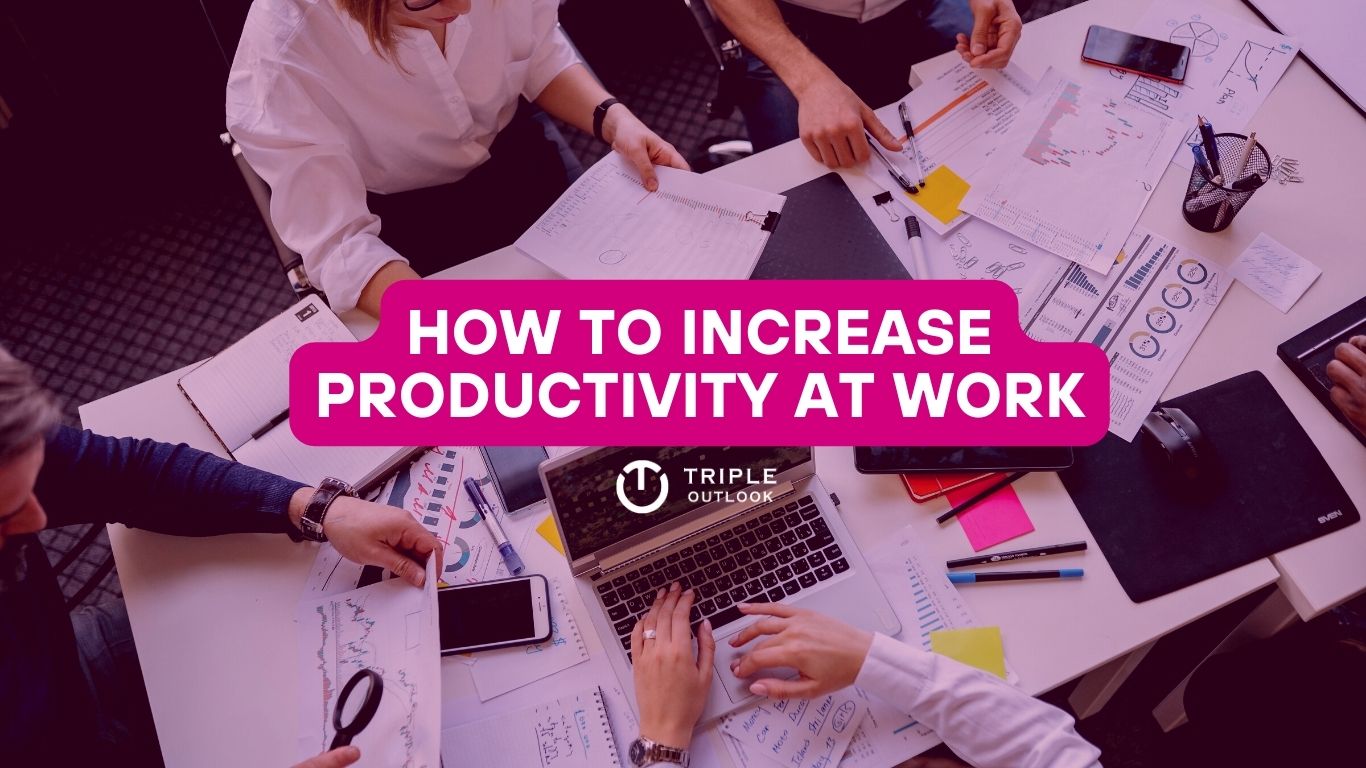Does your workday often feel like a rollercoaster ride, with tasks piling up and your productivity slipping away?
You begin each day with a clear plan and high hopes of accomplishing a lot, but somehow, you end up getting sidetracked, engaging in low-priority activities, and falling victim to procrastination.
It’s frustrating, but don’t worry – there’s a way to regain control of your time and increase productivity at work. In today’s fast-paced world, being productive is crucial for achieving success. Right? And productivity is all about getting things done efficiently and effectively.
When you’re productive, you can accomplish more tasks in less time, leaving you with a sense of achievement and reducing stress. That’s what we are going to discuss today. So, let’s explore some proven ways that will help you increase productivity at work!
Setting the Stage for Productivity at Workplace

#1 Define Your Goals:
To be productive at work, it’s essential to have clear and achievable goals. Goals provide a sense of direction and purpose, helping you stay focused and motivated. Here are some tips to help you set effective goals:
- Be Specific: Clearly define what you want to achieve. You already know the quarterly/yearly goals, depending on your profile. Instead of a vague goal like “improve sales,” make it more specific like “increase monthly sales by 10%.” or anything related to your profile. Just define it.
- Make Them Measurable: Your goals should have measurable criteria to track your progress and determine success. For example, “complete five customer service training modules by the end of the month.”
- Ensure They Are Attainable: Set goals that are challenging yet realistic. Avoid setting yourself up for failure by creating unattainable goals. Break larger goals into smaller, manageable tasks for a sense of accomplishment along the way.
- Keep Them Relevant: Align your goals with your overall objectives and values. They should be meaningful and contribute to your personal and professional growth.
- Time-Bound: Set a deadline or timeframe for achieving your goals. This helps create a sense of urgency and motivates you to take action.
#2 Prioritize Your Tasks:
Not all tasks are created equal, and prioritizing them effectively is crucial for productivity. The Eisenhower Matrix is a useful tool for task prioritization. It categorizes tasks based on urgency and importance into four quadrants:
- Urgent and Important: These tasks require immediate attention and should be your top priority. They have significant consequences if not addressed promptly, such as deadlines or critical issues.
- Important but Not Urgent: These tasks contribute to your long-term goals but don’t require immediate attention. Schedule time for these tasks to prevent them from becoming urgent later.
- Urgent but Not Important: These tasks may demand your immediate attention but don’t necessarily align with your goals. Delegate or minimize these tasks as much as possible to focus on more important responsibilities.
- Not Urgent and Not Important: These tasks are distractions and time-wasters. Avoid them whenever possible to maximize your productivity.
Determining urgency and importance can be subjective, but here are some techniques to help you:
- Consider deadlines, impact on others, and consequences of not completing a task.
- Evaluate if a task aligns with your goals or has a significant impact on your work.
- Assess the potential long-term benefits or drawbacks of each task.
#3 Create a Daily Routine:
A well-designed daily routine can significantly increase productivity at work. Here are some strategies to maximize your efficiency throughout the day:
- Identify Your Most Productive Times: Understand your energy levels and focus peaks throughout the day. Schedule your most important and challenging tasks during these times when you’re at your best.
- Start with a Morning Routine: Establish a morning routine that sets a positive tone for the day. Include activities like exercise, meditation, or planning your day to kickstart your productivity.
- Break Tasks into Time Blocks: Allocate specific time blocks for different tasks or projects. This helps create a sense of structure and prevents tasks from taking up more time than necessary.
- Prioritize Deep Work: Dedicate uninterrupted blocks of time for focused, deep work. Minimize distractions, such as turning off notifications or finding a quiet workspace, to maximize your concentration.
- Take Regular Breaks: Breaks are crucial for maintaining productivity at workplace and preventing burnout. Schedule short breaks between tasks to recharge, stretch, or engage in quick mindfulness exercises.
These strategies will help you stay focused, make progress toward your goals, and make the most of your time and energy throughout the day. Remember, consistency
Mastering Time Management

#4 Eliminate Time Wasters:
To increase productivity at work, it’s crucial to identify and eliminate common time wasters and distractions. Here are some tips to help you minimize distractions and optimize your focus:
- Identify Distractions: Take note of activities or situations that tend to divert your attention. Common distractions include social media, excessive email checking, unnecessary meetings, or cluttered workspaces.
- Limit Screen Time: Set boundaries for your screen time and use technology intentionally. Consider using website blockers or apps that limit access to distracting websites or social media platforms during work hours.
- Manage Email Efficiently: Schedule specific times to check and respond to emails rather than constantly monitoring your inbox. Utilize filters and folders to organize and prioritize emails, ensuring that important messages receive prompt attention.
- Create a Distraction-Free Environment: Organize your workspace and remove unnecessary clutter. Minimize interruptions by using headphones, closing unnecessary tabs or applications, and communicating with colleagues when you need uninterrupted focus.
#5 Practice the Pomodoro Technique:
The Pomodoro Technique is a popular time management method that can help improve focus and productivity at work. Here’s an overview of how Pomodoro technique works:
- Set a Timer: Choose a specific task you want to work on and set a timer for 25 minutes. (This is called one “Pomodoro”).
- Work Intensely: Focus solely on the task at hand for the entire 25 minutes, avoiding any distractions. This concentrated effort is known as a “Pomodoro session.”
- Take a Short Break: After each Pomodoro session, take a short, five-minute break to relax and recharge. Use this time to stretch, take a quick walk, or do something enjoyable to clear your mind.
- Repeat and Track Progress: After completing four Pomodoro sessions, take a more extended break of around 15-30 minutes. Then, repeat the process, aiming to complete several Pomodoro cycles throughout your workday.
It’s a time management method that involves breaking down work into focused, 25-minute intervals called “pomodoros,” separated by short breaks.
- Set a timer for 25 minutes and work on a specific task until the timer goes off
- After each Pomodoro, take a short break to recharge before beginning the next 25-minute task.
The Pomodoro Technique helps break work into manageable, focused intervals, increasing productivity at workplace while also allowing for regular breaks to prevent burnout. Experiment with the duration of your Pomodoros and breaks to find what works best for you.
#6 Delegate and Collaborate:
Recognizing the power of delegation and teamwork is essential for productivity at workplace. Here are some tips to effectively delegate tasks and leverage the strengths of your team:
- Identify Strengths: Understand the strengths and expertise of your colleagues or team members. Assign tasks that align with their skills, interests, and experience to maximize efficiency.
- Communicate Clearly: When delegating tasks, provide clear instructions, expectations, and deadlines. Ensure that the person understands the task and has the necessary resources to complete it successfully.
- Foster Collaboration: Encourage open communication and collaboration within your team. Create opportunities for brainstorming, sharing ideas, and problem-solving together. Leverage the diverse perspectives and talents within your team to achieve better results.
- Regularly Review Progress: Stay involved in the delegated tasks by periodically checking in on progress and offering support when needed. Provide constructive feedback and praise for a job well done, fostering a positive and productive work environment.
Delegation and collaboration allow you to distribute workload, tap into the collective knowledge and skills of your team, and accomplish tasks more efficiently.
Boosting Work Efficiency

#7 Optimize Your Workspace:
Your workspace plays a significant role in your productivity. Here are some strategies to create an efficient and organized work environment:
- Declutter Your Space: Remove unnecessary items and keep your workspace tidy. A clutter-free environment reduces distractions and promotes focus.
- Organize Supplies and Tools: Arrange your supplies, documents, and tools in a way that is easily accessible. Use storage solutions like trays, folders, or bins to keep everything in order.
- Ergonomics: Ensure your workspace is ergonomically designed to promote comfort and prevent strain or injuries. Adjust your chair, monitor, and keyboard to maintain proper posture.
- Personalize with Purpose: Add elements that inspire and motivate you, such as plants, artwork, or quotes. Keep personal items minimal to avoid excessive distractions.
#8 Harness the Power of Technology:
Technology can be a valuable ally in enhancing productivity. Here are some ways to utilize productivity tools and apps:
- Task Management: Use digital task management tools like Todoist, Trello, or Asana to organize and prioritize your tasks. Break larger tasks into smaller subtasks for better clarity and progress tracking.
- Time Tracking: Track your time spent on different activities using apps like Toggl or RescueTime. This helps identify time-consuming tasks and allocate time more efficiently.
- Collaboration Tools: Embrace collaboration tools such as Slack, Microsoft Teams, or Google Workspace to streamline communication, file sharing, and project collaboration with teammates.
- Automation: Explore automation tools like Zapier to automate repetitive tasks or create workflow integrations. This frees up time for more important and high-value activities.
#9 Continuous Learning and Skill Development:
Personal growth and skill development directly contribute to your productivity at workplace. Here are some suggestions for continuous learning:
- Online Courses: Take advantage of online learning platforms like Coursera, Udemy, or LinkedIn Learning to enhance your skills. Explore courses related to your field or areas of interest.
- Workshops and Webinars: Attend workshops or webinars relevant to your industry or areas of improvement. These events offer valuable insights, networking opportunities, and practical knowledge.
- Reading: Cultivate a habit of reading books, articles, or blogs related to your profession. Stay updated on industry trends, best practices, and personal development topics.
- Seek Feedback and Mentorship: Actively seek feedback from colleagues, supervisors, or mentors to identify areas for improvement. Learn from experienced individuals who can offer guidance and support.
Continuous learning and skill development not only enhance your abilities but also boost your confidence and adaptability. Embrace new knowledge and stay curious to fuel your personal and professional growth.
Nurturing a Healthy Work-Life Balance

#10 Take Regular Breaks:
Taking regular breaks is essential for maintaining productivity at workplace and preserving your mental well-being. Here are some techniques to incorporate short breaks into your workday:
- Microbreaks: Integrate microbreaks of a few minutes every hour or two. Use this time to stretch, take a quick walk, or do a brief breathing exercise to rejuvenate your mind and body.
- Pomodoro Breaks: Follow the Pomodoro Technique mentioned earlier, where you take short breaks of five minutes after each 25-minute work session. Use this time to relax, hydrate, or engage in a quick mindfulness practice.
- Change of Scenery: During longer breaks, step away from your workstation. Go outside, if possible, or move to a different area of your workspace to refresh your mind and reduce monotony.
#11 Embrace Healthy Habits:
Your physical and mental health significantly impact your productivity. Here are some tips to maintain overall well-being and enhance productivity:
- Exercise Regularly: Engage in physical activities that you enjoy, such as walking, running, yoga, or dancing. Exercise boosts energy levels, reduces stress, and improves focus and concentration.
- Eat Nutritious Meals: Prioritize balanced meals that include fruits, vegetables, whole grains, and lean proteins. Avoid excessive sugar and caffeine, as they can lead to energy crashes and decreased productivity.
- Practice Stress Management: Incorporate stress management techniques like deep breathing exercises, meditation, or journaling into your daily routine. These practices help reduce stress and promote mental clarity.
- Get Adequate Sleep: Aim for 7-9 hours of quality sleep each night. Sufficient rest improves cognitive function, memory, and problem-solving abilities, leading to increased productivity during the day.
#12 Unplug and Recharge:
Creating boundaries between work and personal life is vital for maintaining a healthy work-life balance. Here are some strategies to unplug and recharge outside of work hours:
- Set Clear Boundaries: Establish designated work hours and communicate them to your colleagues and clients. Avoid responding to work-related emails or messages outside of these hours unless it’s an emergency.
- Create a Work-Free Zone: Designate specific areas in your home or personal space where work-related activities are not allowed. This separation helps create a mental distinction between work and leisure time.
- Engage in Hobbies and Leisure Activities: Dedicate time to activities you enjoy outside of work, such as hobbies, reading, spending time with loved ones, or pursuing personal interests. These activities rejuvenate your mind and promote work-life balance.
- Practice Digital Detox: Take intentional breaks from electronic devices. Set specific times each day or allocate entire weekends for disconnecting from work-related technology. Use this time to engage in offline activities and recharge.
Nurturing a healthy work-life balance is essential for sustainable productivity and overall well-being. By incorporating regular breaks, embracing healthy habits, and setting boundaries, you’ll create a harmonious integration of work and personal life, leading to increased happiness and success in both domains.
Conclusion
Achieving productivity at work goes beyond just working harder or longer hours. It requires a holistic approach that encompasses goal-setting, task prioritization, effective time management, a well-optimized workspace, leveraging technology, continuous learning, and nurturing a healthy work-life balance. By implementing the strategies outlined in this blog, you’ll be well on your way to becoming a productive powerhouse, capable of achieving remarkable success in your chosen endeavors. Remember, productivity is not about working more, but rather working smarter and maintaining a balanced approach to life. So, go forth, embrace these techniques, and unlock your full potential!
Frequently Asked Questions around Increasing Productivity at Work
There are many ways to improve productivity as discussed above, but here are five effective ways to improve productivity at workplace:
1. Prioritize tasks
2. Minimize distractions
3. Take breaks
4. Delegate tasks
5. Improve time management
Experiment with different ways and find what works best for you to enhance your productivity and achieve your professional goals.
Increasing productivity in the workplace can be achieved through various strategies and approaches. Here are some examples:
1. Streamlining Processes: The Marketing Department can streamline processes by implementing marketing automation tools.
2. Setting Realistic and Challenging Goals: The Marketing Department can set SMART goals for various marketing campaigns or initiatives.
3. Work-Life Balance: To promote work-life balance, the Marketing Department can implement flexible work arrangements.




